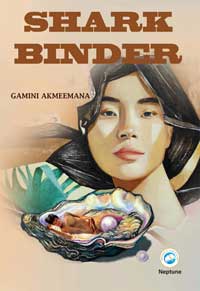The Shark Binder: Inter-racial love in the time of colonial Sri Lanka
Gamini Akmeemana’s novel ‘The Shark Binder’ is a fascinating study of life in British-ruled Ceylon of the 1920s. It is also a fascinating hypothesis of inter-racial love between a young, idealistic Frenchwoman and a Lankan Tamil pearl diver.
I call this a hypothesis because inter-racial love resulting in marriage would have been very difficult, if not impossible, given the time, place and context. That Genevieve Dumont is French, not English, hardly matters. In plain English, it’s a white-brown issue.
 Add to this the social disparity – she is middle class, while Raju the pearl diver is very poor – and we have a story that challenges the reader’s credibility, not to mention that it would test even a seasoned novelist’s ability, as we are transported not to the make-believe world of cheap romances or celluloid (or nowadays digital cinema), but to the more exacting sphere of literary fiction.
Add to this the social disparity – she is middle class, while Raju the pearl diver is very poor – and we have a story that challenges the reader’s credibility, not to mention that it would test even a seasoned novelist’s ability, as we are transported not to the make-believe world of cheap romances or celluloid (or nowadays digital cinema), but to the more exacting sphere of literary fiction.
I began reading The Shark Binder with some misgivings. But, I was soon drawn into the inner world of Genevieve Dumont, brought up in austerity by her doctor parents in the quiet French enclave of Pondicherry in South India; she travels to Sri Lanka to recover from the horrors of World War I that she witnessed in France as a volunteer nurse.
Her taste in books is described. We know what she thinks of colonialism and imperial powers, including her own country France. But what fascinated me was the way the author describes the inner workings of Genevieve’s mind. All good writers from Tolstoy to Chekhov have had a firm grasp of the feminine psyche, and I have never come across a novel by a Lankan writer with that degree of skill in constructing a woman-centered narrative, inviting the reader to come along, from a mostly feminine point of view.
There are two points of view here – Raju’s and Genevieve’s. Before elaborating on that, let me add that the author is equally adept at describing opposing cultures – Eastern and Western. This is something not easily found not just in Lankan fiction but in literary fiction elsewhere. After E. M. Forster, who portrayed a cross-cultural milieu memorably in his “A Passage to India,” it’s Arundhati Roy who achieved that level of accomplishment with her “God of Small Things.” In this novel, Gamini Akmeemana presents an equally convincing cross-cultural portrait of life in Sri Lanka a century ago.
Genevive’s point of view, sets the tone for the entire narrative, and it looks to be the dominant one. Psychologically, it has to be so since Raju the pearl diver, of very humble origin, cannot be the dominant character. The author does not cast him in some heroic mould, full of fire and fury against colonial rule and pleased to have a white woman as his lover and follower. That sort of treatment would have taken this book to the level of pulp fiction, and the author wisely and adroitly avoids that trap.
But Raju is not a younger version of Uncle Tom, either. He does have a smouldering fire inside him. But it’s personal, the pain of having deserted his mother and given up his studies to realise a dream of riches as a pearl diver. This makes him very real and endearing as a character. Both he and Genevieve carry a lot of pain within themselves, albeit of different kinds.
There is a gallery of secondary characters which makes this book really come alive. The character of ex-British army sergeant William Weatherby adds colour and depth to the story. After being punished for hitting an officer, he turns renegade and goes ‘native’, a wandering philosopher living off the land.
The Walcott family – government agent James Walcott and his wife, are credible portraits of colonial self-righteousness and imperial haughtiness. Genevieve is employed as the French teacher and governess to the Walcott’s two children.
This portrait of British imperial superciliousness is offset by a sympathetic cameo portrait of Leonard Woolf, administrator and author of the classic novel ‘Village in the Jungle,’ the most sympathetic and powerful work of fiction of indigenous culture, poverty and a vanishing way of life by a non-Lankan author to date.
Historical romance is a prolific, even overworked, genre in the West, but it is rare in this country. The author has attempted a precarious balancing act and pulled it off successfully. Writing about young love without falling into cliches is very hard, and writing about inter-racial love in the colonial era even more so. He has displayed great imaginative powers in making this narrative very convincing. The setting may be from another era, but the characters and their experiences are universal and timeless.
Searching for an ideal partner? Find your soul mate on Hitad.lk, Sri Lanka's favourite marriage proposals page. With Hitad.lk matrimonial advertisements you have access to thousands of ads from potential suitors who are looking for someone just like you.


